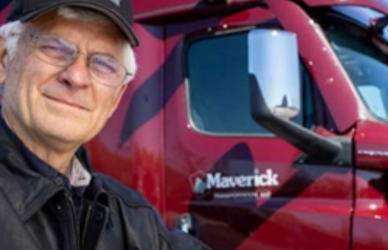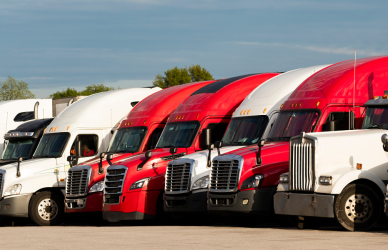In the coming years, the responsibility of transporting the nation’s goods and fueling the economy will increasingly fall on a new generation of professional truck drivers.
However, trucking companies have long faced the challenge of attracting workers to fill these roles. To keep up with the projected growth in freight and counter the wave of retirements on the horizon, fleets must find ways to bring in younger drivers.
To achieve this, fleet operators need to broaden their recruitment efforts and cater to the preferences and expectations of future drivers in terms of work-life balance, career progression, and a sense of belonging.
According to industry leaders, younger workers expect more from a driving career, including flexible schedules, clear paths for advancement, and a supportive community.
“Ultimately, it’s going to come down to culture, work-life balance and stability,” said Pat Udovich, chief human resources officer at less-than-truckload carrier, A. Duie Pyle. “Culture has become king — rightfully so — and we do not see that changing as the next generation comes onboard.”
While work-life balance has long been considered a top concern for drivers, following close behind pay, the younger generation is emphasizing its significance even more.
“A growing percentage of candidates are even opting for lower-paying jobs with a larger amount of home time or flexibility in taking home time,” said Chris Polenz, vice president of recruiting at truckload carrier Werner Enterprises.
Fleets are rapidly adapting and embracing technology to ensure flexible operations. For instance, Werner utilizes its mobile app to efficiently pair drivers with their specific requirements and preferences.
“We have a ‘career opportunities’ tab on our Driver Werner Pro App allowing drivers to search for existing accounts that meet their work-life balance,” Polenz said. “From there, they can select to be added to those wait lists or talk to a career center specialist at any time to discuss their requests.”
Dee Dee Cox, the VP of Human Resources at Old Dominion Freight Line, revealed that the company has adopted a more innovative approach to scheduling its drivers. This necessitates fostering transparent communication about both the company’s and employees’ requirements, beginning from the initial interview phase.
She says they make sure they’re asking the right questions from the very start. “What is the driver looking for in the long term? Is it OK if the driver is off on Tuesday and Wednesday? Do those days actually work better for home life, or are they looking for a Saturday-Sunday reset?”
- Duie Pyle offers LTL and dedicated driving jobs that allow candidates to have a flexible schedule outside of work, according to Udovich. He explains that many people find the opportunity to be home daily appealing because it allows them to attend important events in their personal lives, such as their children’s activities and important events.
Although there is a growing demand for more time at home and flexibility among drivers, some young drivers are content with being on the road for longer periods of time.
Andy Turi, a 23-year-old driver who joined Brenny Transportation a year ago, is one such driver who enjoys being on the road. Turi obtained his commercial driver’s license at 18 and worked regionally until he turned 21.
“Becoming an OTR driver became more enticing because I could live in my truck and get paid,” Turi said. “I have saved tens of thousands of dollars.”
He admits he went from being lured by pay to developing a deep admiration for the trucking industry.
“I’m not doing it for the money anymore,” Turi said. “I like being by myself and getting paid to go places I haven’t been before.”
Garner Trucking has tackled the challenge of driver retention head-on. CEO Sherri Garner Brumbaugh shared her company’s strategy to combat the allure of home-daily opportunities. By adapting their freight transportation networks whenever possible, they have successfully boosted driver retention rates.
This approach ensures that Garner Trucking drivers spend less time away from home while still enjoying a fulfilling career on the road. With its new retention strategy, the company aims to solidify its position as a top choice for drivers seeking a balance between work and home life.
“Relaying, slip seating OTR operations, and drop-hook keep a driver moving and not sitting. Creativity many times brings efficiencies to your operation as well,” said Brumbaugh, who is a past chair of American Trucking Associations. “At Garner, we have multiple driving schedules an individual can choose from. Unlike my father’s generation, that lived to work, this generation and mine is ‘work to live.’ ”
Pay remains important for drivers, but Brumbaugh has discovered that younger employees also value experiences.
“The trucking industry should be able to provide both — good pay and the experience to see the country,” she said. “Marketing those stories is key.”
How Companies are Attracting Younger Drivers
Brenny Transportation, headquartered in St. Joseph, Minnesota, is actively targeting young drivers by collaborating with the Minnesota Trucking Association’s training program.
“We can bring them on locally at 18 years old until they’re of the age to leave the state,” said company founder and CEO Joyce Brenny, who emphasized the carrier’s safety rating and its slow, graduated training process.
A new initiative is aiming to bring more young people into the trucking industry by lowering the minimum age for interstate truck drivers from 21 to 18. This move has been encouraged by industry experts, such as Garner Trucking’s Brumbaugh, who is urging carriers to participate in the Federal Motor Carrier Safety Administration’s (FMCSA) Safe Driver Apprenticeship Pilot Program.
“The Infrastructure Investment and Jobs Act requires the FMCSA to establish an apprenticeship pilot program that would allow drivers between the ages of 18-20 with an intrastate commercial driver’s license to operate interstate, but it requires a trucking company to follow rigid rules to participate,” she said.
Participating as a carrier and apprentice trainer may be a tough journey, but it’s absolutely essential, according to Brumbaugh.
“If we as an industry fail to participate, we will be the barrier ourselves to attracting a younger generation to our beloved trucking industry,” she said.
Lindsey Trent, president, and co-founder of the Next Generation in Trucking Association, emphasizes the need to attract young talent to the industry at an early stage. Rather than waiting until potential hires reach the age of 18, the trucking industry must find proactive ways to engage young people during their high school years.
“They are getting bombarded from other industries — welding, plumbing, and electricians — and trucking needs to be a part of the conversations, too,” Trent said.
She added that the Gen Z workforce is smaller, and skilled trade jobs are growing. “Pair that with the aging workforce that is retiring, and that could equal disaster for our future.”
NextGen Trucking collaborates with student organizations to showcase lucrative trucking careers to school guidance counselors.
“We have careers that are high skill, high wage, and high demand, but young people need to be educated about them in order to be attracted to them,” Trent said.
More and more teenagers are graduating from high school without a driver’s license, presenting an additional challenge.
“Acquiring a CDL builds upon an individual’s personal driving record,” Garner Trucking’s Brumbaugh said. “Trucking companies should work collaboratively with our communities to share the importance of obtaining a driver’s license.”
Diversify Your Work Force
According to Ellen Voie, the founder of Women in Trucking, a nonprofit dedicated to empowering women in transportation, women currently make up almost 14% of the over-the-road driver workforce, though she predicts this number will only keep growing.
“More and more women are seeing the opportunity to earn a middle-class income while being able to travel,” she said.
Young people in the trucking industry need female role models to inspire them and let them know they are valued. According to Trent from NextGen Trucking, fostering a welcoming environment is crucial.
“We need to actively put that messaging out there,” she said.
By attracting employees from diverse demographics, we can also help strengthen the industry’s workforce.
“Every person can come into the trucking industry, and there should be no barriers because of gender, race, or identity,” Garner Trucking’s Brumbaugh said.
It is Voie’s belief that the industry will see more Hispanic and Eastern European drivers in the near future.
“There have been a lot of refugees entering the country, and if we can embrace their customs and accommodate them, we can train them to become professional drivers,” she said.
Show Us Your Tech!
In the fast-paced world of trucking, embracing technological advancements has become essential for recruiting top talent. Old Dominion Freight Line, a leading trucking company, recognizes the power of modern truck technology in attracting high school students and potential workers from Generation Z, according to Cox, a company representative.
By showcasing the advanced technology installed in their trucks, Old Dominion Freight Line is capturing the attention of young individuals who are seeking cutting-edge career opportunities. With a focus on innovation and efficiency, the company is shaping the future of the trucking industry and inspiring a new generation of skilled professionals.
“When we have on-site career fairs, it is important for potential hires to see the equipment they will be working with,” she said. “Once they see the technology, their eyes open up as this is not something they expected.”
According to Rich Johnson, vice president of school operations at Werner, technology can be a game changer when it comes to differentiating yourself from other companies.
“The next generation has a higher expectation on how ‘connected’ they are to their company, whether it is company apps, in-cab communications, or ways for family to stay connected with them while they are on the road,” he said.
Offer More Than a Job – Offer a Career
Research has shown that younger people have become more interested in seeing career progression opportunities.
“Gen Z wants to see defined career paths and what you will do as a company to invest in your employees and their future,” NextGen Trucking’s Trent said. “Do you provide a mentorship program, ongoing training, or tuition reimbursement? Gen Z wants to work for a company that cares about them and that will develop them.”
UPS Inc. prioritizes internal growth, says Jim Mayer, the senior director of media relations and network communications. The company mainly recruits and advances drivers from their own ranks. New hires typically start by handling packages within UPS facilities.
“After some time in that role, they can bid and train for full-time positions as drivers,” Mayer said. “For those who want to advance their career, the sky is the limit. Our previous CEO, David Abney, started his career loading trucks in Mississippi.”
30-year-old twin sisters, Alyssa and Brittney Strickland, began their journey at UPS by handling packages. However, they didn’t stop there. They went on to earn their CDLs and are now proud supervisors within the company’s Class 8 “feeder” operations.
“A lot of young people are willing to go into this area, but they don’t know about it,” Alyssa Strickland said, adding that 21 year olds can take advantage of great opportunities immediately. “We give them that free training, and they can get their CDL.”
- Duie Pyle’s truck driving academy and leadership development program are among their top recruiting tools.
“We want to give all our emPloyees, not just drivers, the opportunity to continue to grow and expand their skill sets,” Udovich said.
In an ever-evolving trucking industry, drivers are seeking ways to expand their career horizons. According to Reymer from DriverReach, many drivers are keen on exploring roles in dispatch, maintenance, safety, and management functions.
Werner’s Polenz attests to this trend, as many of Werner’s professional drivers have seamlessly transitioned into non-driving positions within the company’s safety and operations departments.
What sets these drivers apart? Possessing a Commercial Driver’s License (CDL) allows them to bring a unique understanding to these roles.
“It is easier to dispatch when you know what is going on,” Brittney Strickland said. “A CDL is a great thing to have even if you don’t use it.”
Isabella Johnson, an 18-year-old, who recently obtained her CDL and is currently employed at Concrete Products in Rhinelander, Wisconsin, says that while she’s not currently considering a career in over-the-road trucking, she recognizes the potential flexibility that having a CDL can offer her in the future.
“I work with big machinery, and I wanted to be able to haul whatever I wanted whenever I needed,” she said.
Build An Awesome Culture – and Show it Off
Creating a strong company culture is crucial when it comes to attracting and keeping drivers who value teamwork and a sense of belonging.
“They deserve information about what is happening, changes that are coming, and how the company is doing,” ODFL’s Cox said. “Sometimes, I think that aspect can be overlooked as we get caught up in the day-to-day, but it is essential drivers know what is going on with the company and know they play a crucial role in its success.”
Younger workers are growing tired of hierarchies, according to Brenny.
“I’m not saying they shouldn’t earn their stripes, but they want it known that they have a voice and are part of the team,” she said.
Gen Z’s altruistic nature drives them to seek ways to make a positive impact on society. Brenny Transportation recognizes this and introduces its “Haul of Fame,” showcasing the vital products it has transported.
“We talk about the difference they’re making and the lives that they are making better,” Brenny said. “Talking about those things is inspiring, and they need to have that sense of purpose and how important their job is.”
Source: Transport Topics











